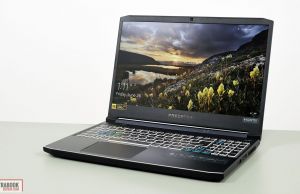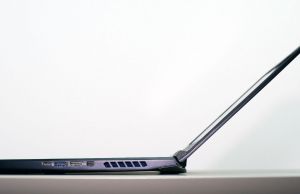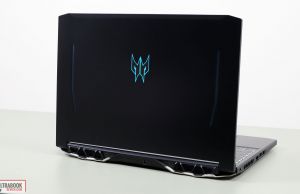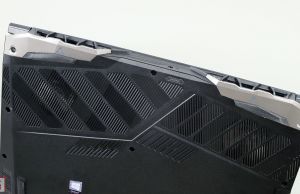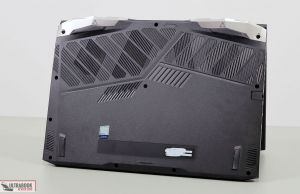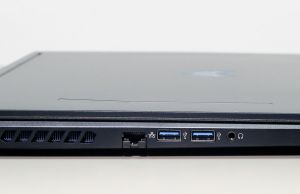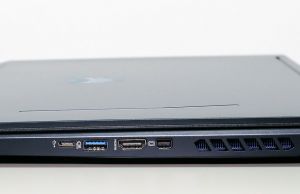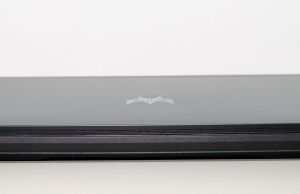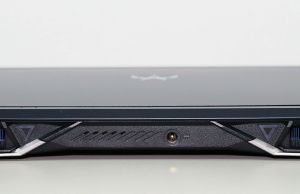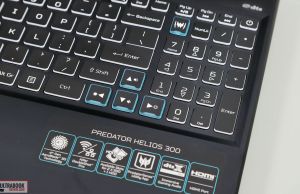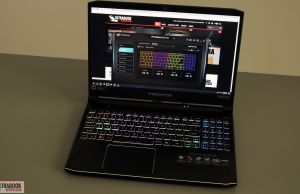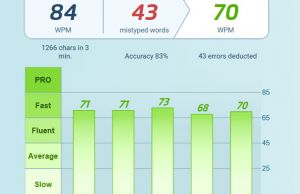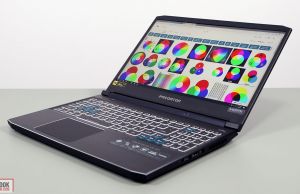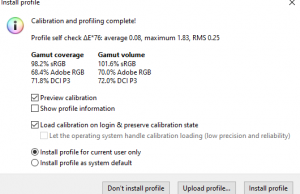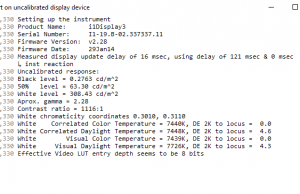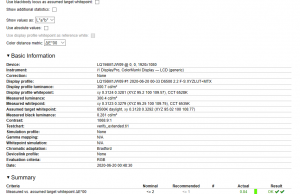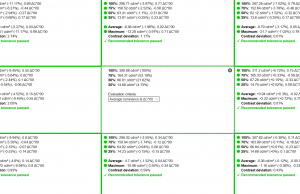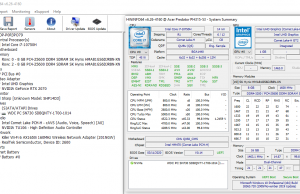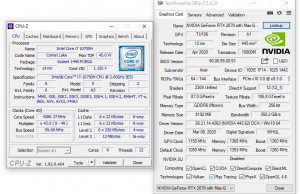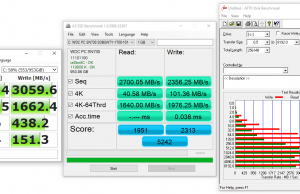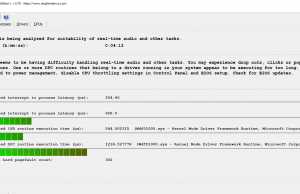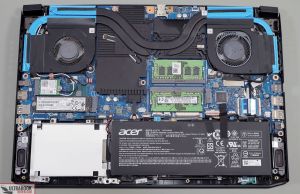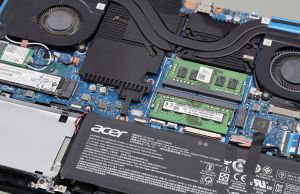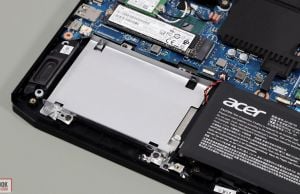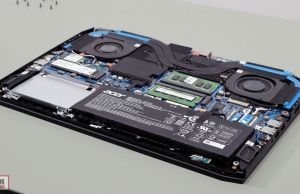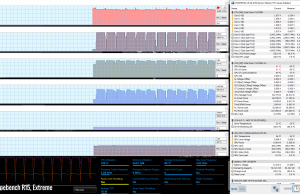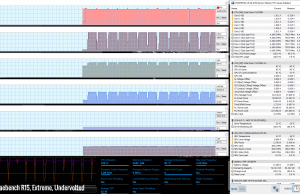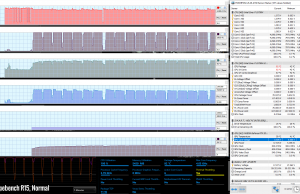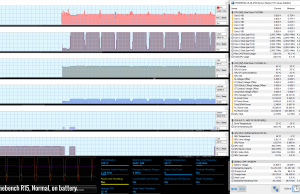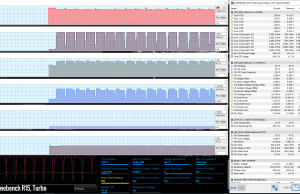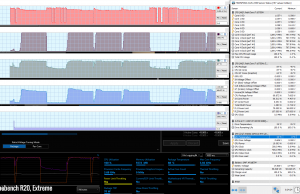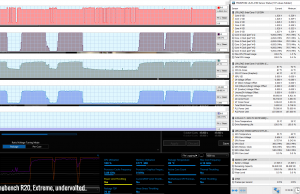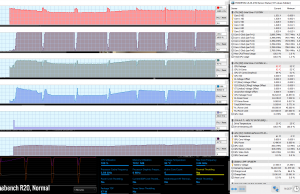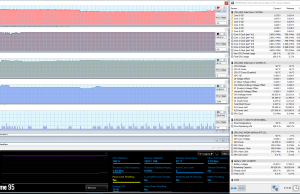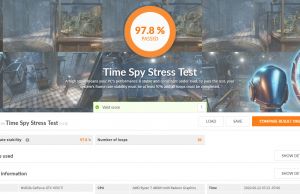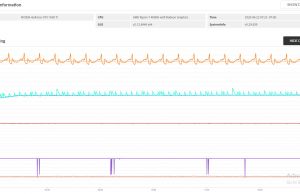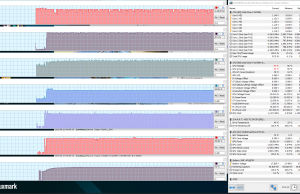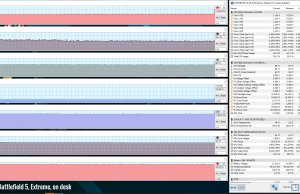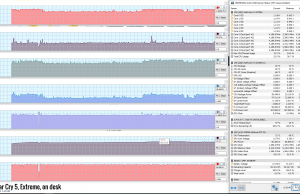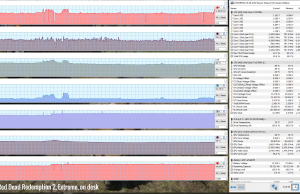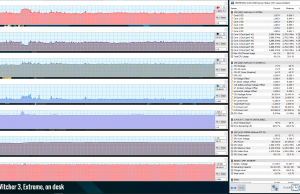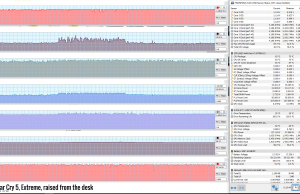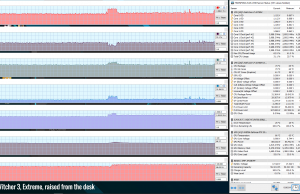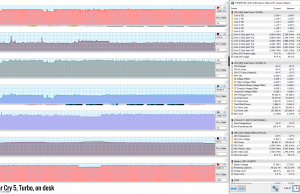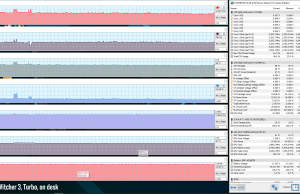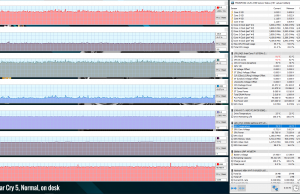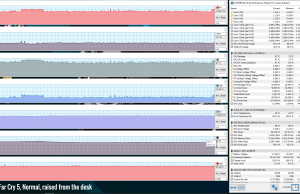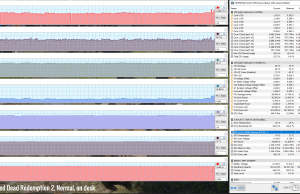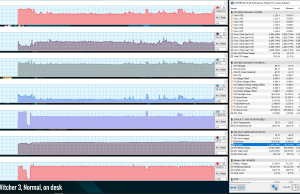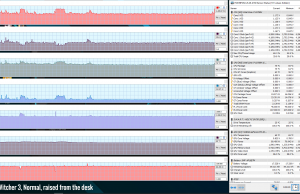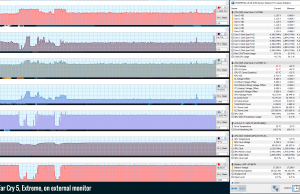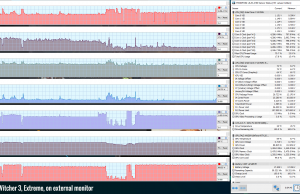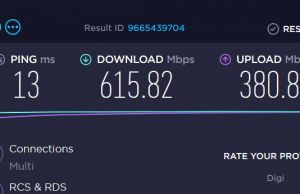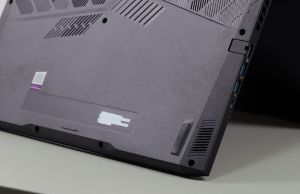For the last years, Acer’s Predator Helios 300s have been among the best selling and most recommended performance/gaming/all-purpose laptops on the market, and for good reason.
We’ve reviewed all the available Helios 300s over time, and this article gathers our thoughts on the most recent 2020 model, the 15-inch Predator Helios 300 PH315-53. A detailed look at the 17-inch variant will also be available soon, stay tuned for it.
Compared to the previous 2019 Helios 300, this generation offers the expected bump to 2020 hardware, but on a first glance, it otherwise feels and looks much like its predecessor. However, on closer inspection, you’ll find that Acer also improved on a few other aspects, such as the display options or thermal design, among others.
We’ve used our review unit for the last few weeks, long enough to figure out its strong points and its quirks, and also long enough to compare it with some of the other performance laptops in its class.
Our configuration is the higher-tier model available, with an Intel Core i7 processor, Nvidia RTX 2070 Max-Q graphics and a 240 Hz display, but most of this article applies to the other configurations as well. Furthermore, we’ll also update the article once we get to test the 2060 / 144 Hz screen model, which is the best-value option, currently available for $1200 in the US and under 1400 EUR here in Europe (follow this link for updated pricing info).
The specs sheet as reviewed – Acer Predator Helios 300
| Acer Predator Helios 300 PH315-53 gaming laptop | |
| Screen | 15.6 inch, 1920 x 1080 px resolution, IPS, 240 Hz, matte, AU Optronics AUO82ED panel |
| Processor | Intel Comet Lake Core i7-10750H, six-core |
| Video | Intel UHD and Nvidia GeForce RTX 2070 8GB 90W OC (GeForce 446.14) |
| Memory | 16 GB DDR4 RAM 2933 MHz (2x 16 GB DIMMs) |
| Storage | 1x 1 TB SSD (WDC PC SN730), 2x M.2 slots + 2.5″ bay |
| Connectivity | WiFi 6 (Killer 1650i) with Bluetooth 5.0, Realtek Gigabit Ethernet LAN |
| Ports | 3x USB-A 3.2 gen2, 1x USB-C gen 2 – data only, HDMI 2.0, miniDP, LAN, headphone/mic, Kensington Lock |
| Battery | 58 Wh, 230 W power adapter |
| Size | 363 mm or 14.27” (w) x 255 mm or 10” (d) x 22.9 mm or .9” (h) |
| Weight | 2.2 kg (4.85 lb), .75 kg (1.65 lbs) power brick, EU version |
| Extras | RGB backlit keyboard – 4 zones, NumPad, 2x stereo speakers, HD webcam |
Acer offers the Predator Helios 300 PH315-53 in a bunch of different configurations, with various amounts of RAM, types of storage, and either Nvidia GeForce GTX 1660Ti, RTX 2060 or RTX 2070 Max-Q graphics.
Design and exterior
For the most part, the 2020 Helios 300 is built on the same chassis as the 2019 version, but with a few tweaks. Among them, there’s a new set of air intake grills above the keyboard, which add up to the existing thermal design and further facilitate fresh-air intake, and also a slight IO rearrangement, with the PSU now conveniently placed on the back edge, freeing up space on the left where it was previously positioned.
The IO hasn’t practically changed between the two models, and the 2020 variant still gathers the video output ports on the right side, which will clutter your mouse area when hooking up an external screen. It also still doesn’t include a card-reader, and the USB-C port is still a gen1 data-only implementation, so you cannot use it with a proper USB-C external dock or for charging, unlike on the higher tier laptops available these days. On top of all these, I should also add that there are still no biometrics on this laptop, and none of these are unusual for this segment.
The redesign also spurred a less-enjoyable change, the fact that the status LEDs are now placed under the screen and right in your line of sight when watching a movie in a dark room. Not a fan, especially when they were smartly positioned on the side in the previous generation.
Now, it might seem that we’re starting on the wrong foot here with this 2020 Helios 300, but I just wanted to clear out the differences between the 2019 and 2020 variants from the get-go.
Design and build wise, nothing has changed. This laptop is one of the nicest crafted in its class, and it’s important to keep in mind throughout this article that this Helios 300 is actually one of the most affordable mid-range gaming/performance laptops you can buy right now. Of course, pricing differs between regions, but in most markets, this sells for less than its piers from Asus, MSI, HP or even Lenovo. We’re going to pitch it against the competition at the end of this review, and in a separate article.
With that in mind, the Helios 300 feels sturdy and reliable. Aluminum is used for the interior and the lid, in a nice looking dark-blue color that shows fingerprints fairly easily, while the underside is made from a rougher black plastic. The lid still inherits a panel-lit Predator logo and two decorative blue bars (those are not lit), so this isn’t the most subtle in terms of design and might have a hard time being accepted in stricter work and school environments. Acer are among the last to stick with this kind of accents, and it’s doing them no favor. Furthermore, this Helios 300 also inherits the sharp front interior lip and pointy corners from its predecessor, which can unpleasantly dig into the wrists in certain situations.
Yes, I’m nitpicking here, but these are tiny details that will impact your life with this laptop, and it’s best you know what to expect before you buy it. In comparison, Acer’s Predator Triton 300 slightly addresses both these issues, with a friendlier front-lip design, and cleaner exterior, as well as a more ample screen angle. Speaking of, two sturdy hinges keep the screen well in place on the Helios 300, but they only allow it to lean back to about 150 degrees, which is fine fort desk use, but might not suffice in some cases.
As since we’re talking about these small practicality details, I should add that the grippy rubber feet placed on the bottom keep the laptop well anchored on a desk, and that Acer made sure not to obstruct the thermal module in any way, designing sufficient air-intakes on the bottom and above the keyboard, with the hot air being pushed out through the back edge. They also haven’t skimped on the internal thermal design, and we’ll get to that in a bit. The speakers are, however, still firing through those small cuts on the bottom, and they’re still not much in terms of audio quality.
Keyboard and trackpad
Inputs haven’t changed between the 2019 and 2020 generations either, so there’s plenty of info about them online.
For me, this is a fine typer, yet not necessarily one of my favorites. I’m seeing a fair amount of inconsistency between these keyboards that Acer put on their laptops. For instance, this one here looks identical to the one on the Trion 300, yet it felt different, softer and quicker to actuate, which for me resulted in a higher error rate. I remember the same kind of feedback on the 2019 Helios 300, and I’ll update this section once I spend more time with the 2020 17-inch Helios 300 as well.
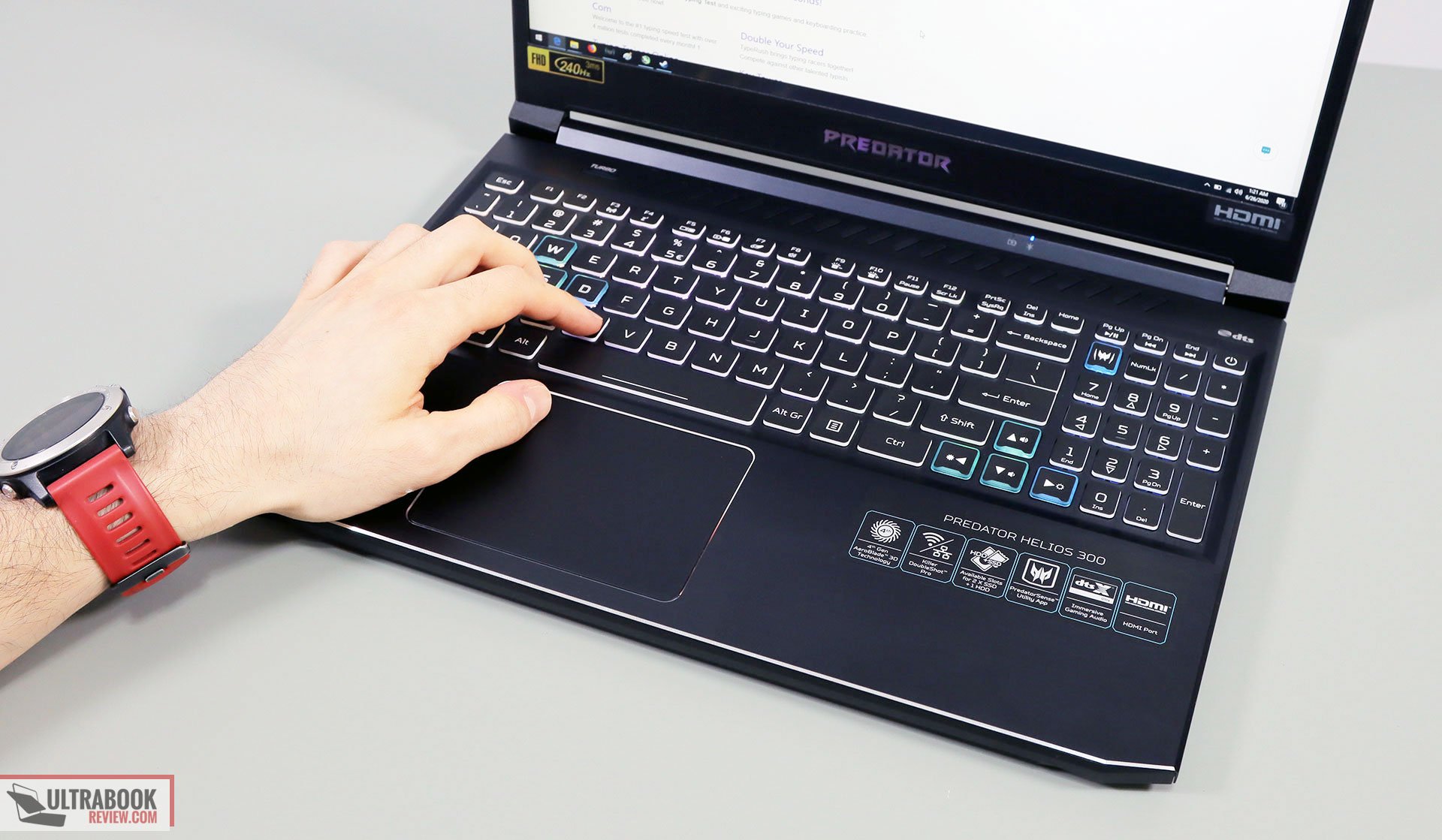
Even with the unforgiving feedback, I feel that this should be a fine keyboard for the average user and one you could learn to live with. The softly coated keys feel very comfortable to the touch, the actuations are quiet, and Acer implemented 26-key rollover that you should find helpful in games.
The layout is full-size, with a main-deck of 15 x 15 mm keys and a narrower NumPad section at the right. Up to you if this is your ideal type of format, it can be a differentiating factor between the options in this segment, with some models offering a centered keyboard without a NumPad, and most of the others going with this same kind of full-size keyboard with a NumPad section.
I should also add that this is a backlit RGB keyboard, with 4 different zones controllable through the dedicated tab in Predator Sense. The implementation is identical to the one on the Triton 300, so not the brightest or the most uniform, but it does what it’s supposed to. Still not a fan of this Acer design without a dedicated Caps-Lock indicator, though, or the amount of light that creeps from under the keycaps from certain angles, helped by the transparent key-sides.
For mouse, Acer went with a mid-sized clickpad that feels like plastic to me, and not glass as on the Trion lineups. It’s a bit rougher and clunckier with taps, but still works alright with everyday use and gestures.
As for biometrics, there aren’t any on this 2020 Acer Predator Helios 300.
Screen
For the screen, Acer offers either 144 Hz or 240 Hz panels on the 2020 Predator Helios 300 lineup, both 15.6-inches in size, FHD in resolution, matte and non-touch.
We got the 240 Hz variant on our test-unit, the one reserved for the higher-tier configurations, and it’s a solid option for gaming and daily use. In fact, it’s the same offered on the higher tier Predator Triton lineups. It’s not very bright, but that aside, there’s little to complain about here.
Here’s what we got in our tests, with a X-Rite i1 Display Pro sensor:
- Panel HardwareID: Sharp SHP14D3 (LQ156M1JW09);
- Coverage: 98.2% sRGB, 72.7% AdobeRGB, 75.3% DCI P3;
- Measured gamma: 2.31;
- Max brightness in the middle of the screen: 308.43 cd/m2 on power;
- Min brightness in the middle of the screen: 20.98 cd/m2 on power;
- Contrast at max brightness: 1116:1;
- White point: 7400 K;
- Black on max brightness: 0.27 cd/m2;
- PWM: No.
- Response: ~17ms GtG (source).
Calibration isn’t great out of the box, with messed upped White Point and Gamma, but once calibrated, the panel turned out to be one of the most uniform in terms of luminosity and color I’ve tested in a while, and a nicer implementation that the same panel tested in the Triton 300.
With this sort of DeltaE color accuracy and 72%+ AdobeRGB coverage, this is not just a solid choice for everyday use, but also a good candidate for occasional color accurate work, such as editing photos/videos, 3D rendering, etc.
However, most Predator Helios 300 configurations still ship with the 144 Hz FHD display. That’s the AU Optronics B156HAN08.2 panel also available on the 2019 Helios 300 and a close match-up for the 240 Hz option. It’s still a roughly 300-nits panel with about 1000:1 contrast ratio and 70% AdobeRGB coverage, so there’s very little reason to frat on if you can only get this on the Helios 300 configurations that you’re looking at.
Hardware and performance
Our test model is a top-specced configuration of the Acer Predator Helios 300 in the 2020 PH315-53 model, with an Intel Core i7-10750H processor, 16 GB of DDR4 2933 MHz RAM, 1 TB of storage and dual graphics: the Nvidia RTX 2070 dGPU and the Intel UHD within the Intel platforms, with Optimus.
Before we proceed, keep in mind that our review unit is an early-production model with the software available as of late-June 2020 (BIOS v0.14, Predator Sense 3.00.3138, GeForce Game Ready 446.14 drivers). While certain aspects might change with future software updates, our results should be mostly what you’ll get with the retail models as well.
Spec-wise, the 2020 Helios 300 tops at a 6Core Intel Comet Lake i7-10750H processor, the one we have on this sample, with i5-10300H models available on the lower-end specs. Intel 8Core processors are only an option on the Triton 500 series, while AMD hardware is only available on very few Nitro models with this generation.
The updated Intel platform also supports up to 3200 MHz DDR4 memory, but out configurations only gets 16 GB of DDR4 2933 MHz RAM in dual-channel, and there are two DIMMs available inside.
For the GPU, what we have here is the Nvidia 2070 non-Super graphics chip from 2019, in a Max-Q implementation with variable GPU TDP and settings between the several performance modes available in Predator Sense:
- Normal – is a balanced everyday profile, with the GPU running at stock frequencies, roughly 80W of power and a balanced fan profile;
- Fast – bumps the GPU to 90W and +50 MHz Core, +30 MHz Memory overclock;
- Extreme – further overclocks the GPU at +100 MHz, +60 MHz Memory, and allows the fans to spin faster.
These are slightly different overclocking settings than on the Triton 300 that we’ve already tested. The Fast/Extreme profiles are only allowed while the laptop is plugged in. There’s also a Turbo mode (activated by pressing the Turbo physical button), which sets the Extreme GPU profile and pushes the fans to their max. That helps reduce temperatures, but with significant noise increase, and it’s not something I can see myself using on a regular basis.
As a side note, these profiles do not directly impact the CPU’s TDP, but thanks to the faster spinning fans on the Extreme profile, the processor is able to run at slightly higher clocks in sustained loads in this case.
As for the storage, our unit gets a single WDC PC SN730 drive, a middling performer that should do fine for the average user, but which can be upgraded if needed. There are two M.2 slots on this laptop, as well as a 2.5″ bay. However, our unit lacked the required connectivity to hook-up a 2.5″ HDD/SSD, and there’s a fair chance you’re not getting the connector with the retail model either unless you opt for a configuration with an included HDD. It’s a standard SATA cable, though, the kind you can easily find on Amazon or eBay.
Accessing the hardware is a simple task and requires removing the bottom panel. Inside you’ll find the two M.2 SSD slots, the Wi-Fi module and two RAM slots, as well as the 2.5 cage, the thermal module, battery and the small speakers flanking it.
This aside, the Predator Helios 300 is a multi-purpose notebook, so it can deal with demanding loads, but also with everyday multitasking, browsing, and video content, while running quietly and coolly. It’s never completely silent, but the fans spin slowly and are only audible in a quiet environment.
With that out of the way, let’s see how this performs in demanding loads. We start by testing the CPU’s performance in taxing chores by running Cinebench R15 benchmark for 15+ times in a loop, with 2-3 seconds delay between each run.
On Extreme (with the fans on Auto), the i7-10750H processor settles for clock speeds of 3.8+ GHz, temperatures of around 90-94 degrees Celsius, and scores of around 1180+ points, with a TDP of 70+W in all runs. Power is the limiting factor here, but the i7 runs towards its maximum clocks and potential, and at higher power than on the Nitro 5 or Triton 300 already tested. Furthermore, the fans keep quiet, at only 42-43 dB at head-level in this test.
Switching over to Normal quiets the fans to barely audible levels of 37-38 dB. Thermals are the limiting factor in this case, but even so, the i7 still runs at around 70W and nearly maximum clocks.
Switching over to Turbo alleviates the thermal restrictions and allows the laptop to run in the mid-80s C, but once more, without any significant impact over the performance.
Undervolting is what normally makes a difference on Intel processors, although that’s more limited with 10th gen platforms. Our unit supports both XTU and Throttlestop, and we were able to stably undervolt it at -100 mV (-125mV was also possible, but we dialed back to prevent any stability issues). In this case, the CPU stabilizes at its full Turbo speed of 4.2 GHz and 62W+ TDP on Extreme, as well as temperatures of 80-83 degrees C.
These are excellent results for the i7-10750H processor in this test, yet somehow they only translate in Cinebench scores of around 1200 points, and not the 1350+ possible with other unrestrained implementations of this same processor. I’d reckon that’s a quirk of our early sample, though, and should change with retail models, as the i7-10750H should score higher in this test at this sort of frequencies, power, and thermals.
Finally, the performance drops on battery, with the CPU being limited to only 25W. All these details are available in the following charts and logs.
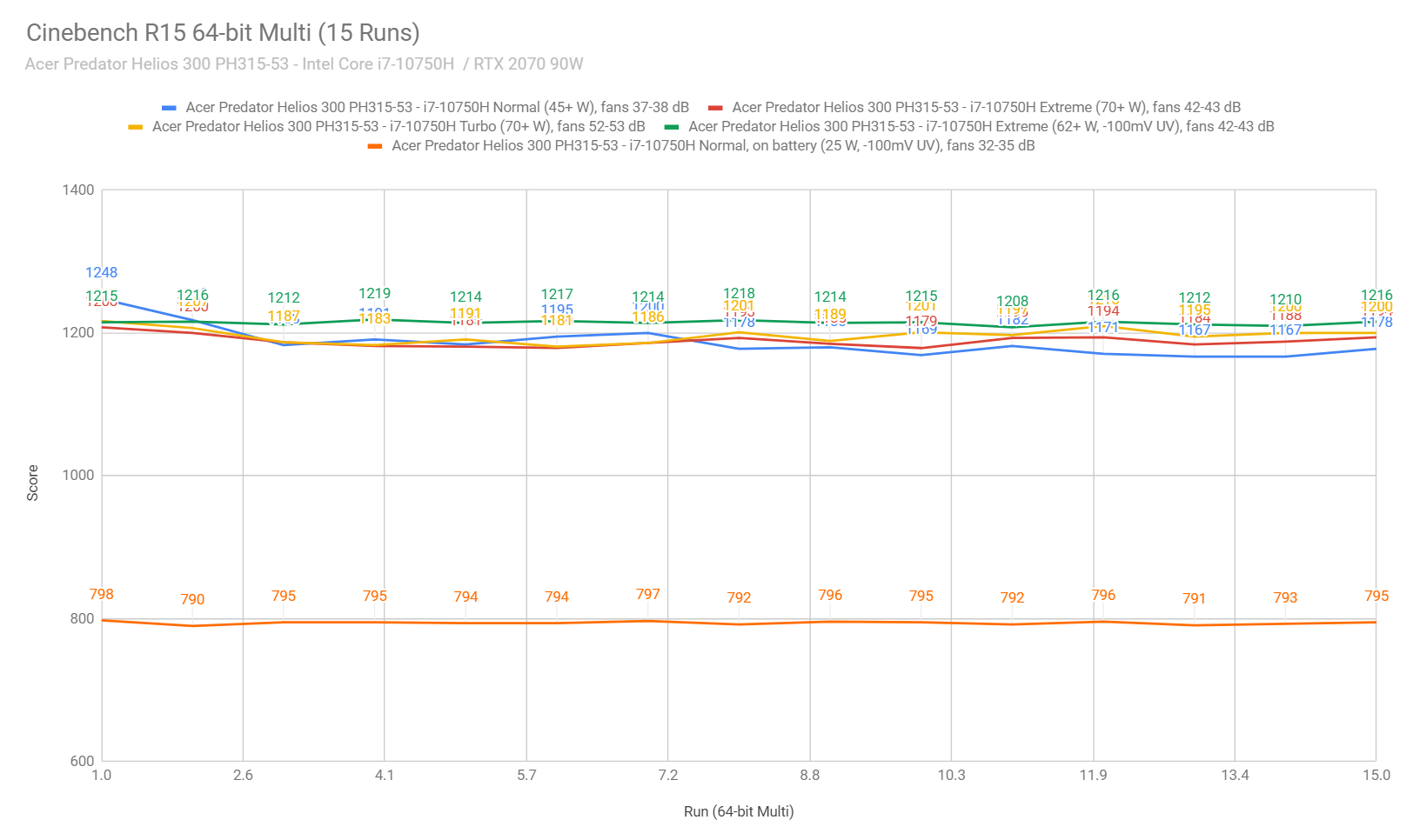
To put these findings in perspective, this Predator Helios 300 performed very well in this test, yet it was outscored by a few other implementations of the i7-10750H platform that we’ve tested, which I expect should not be the case with the final retail variants. I’ve added the 8Core Intel i7 down below, even if that’s only available in more expensive products, but also a few competing AMD Ryzen 4800H models in the chart below, options available in this Helio’s price range, just for a ballpark comparison of the kind of CPU performance gap you can get with the AMD platform these days. Unfortunately, AMD hardware is not available on the Helios 300 chassis at this time.
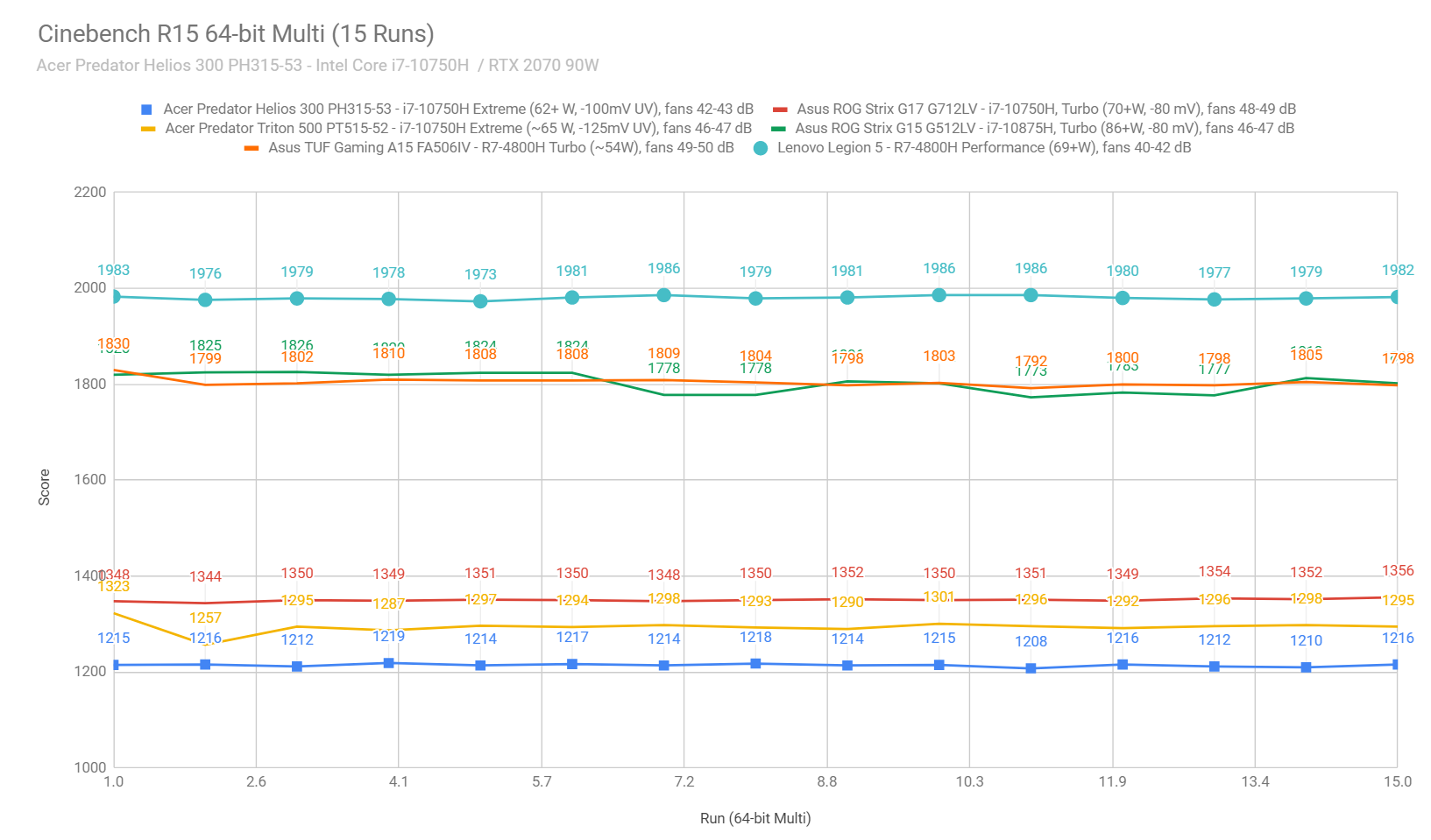
With that out of the way, we then went ahead and further verified our findings with the longer Cinebench R20 loop test and the gruesome Prime 95. The CPU runs at 70+ W on both tests, with fairly quiet fans and high temperatures of 90+ degrees C.
We also ran our combined CPU+GPU stress tests on this notebook. 3DMark stress runs the same test for 20 times in a loop and looks for performance variation and degradation over time, and this unit passed it fine. Luxmark 3.1 fully loads both the CPU and GPU at the same time. The CPU stabilizes at around 55W and 90+ degrees C, with the GPU running at around 90W and 75+ C.
Next, we ran the entire suite of tests and benchmarks, on the stock Extreme profile in Predator Sense.
- 3DMark 13 – Fire Strike: 16882 (Graphics – 19036, Physics – 17992, Combined – 8699);
- 3DMark 13 – Port Royal: 4234;
- 3DMark 13 – Time Spy: 7178 (Graphics – 7193, CPU – 7096);
- AIDA64 Memory test: Write: Read: 40124 MB/s, Read: 41796 MB/s, Latency: 61.0 ns;
- Uniengine Superposition – 1080p Extreme: 4424;
- Uniengine Superposition – 1080p Medium: 13832;
- Handbrake 1.3.1 (4K to 1080p encode): 35.20 average fps;
- PassMark: Rating: 6723 (CPU mark: 15912, 3D Graphics Mark: 11994, Disk Mark: 27526);
- PCMark 10: 5236 (Essentials – 9482 , Productivity – 8298 , Digital Content Creation – 4954);
- GeekBench 4.4.2 64-bit: –Single-Core: 5505, Multi-core: 25187;
- GeekBench 5.0.1 64-bit: –Single-Core: 1221, Multi-core: 6336;
- CineBench R15 (best run): CPU 1332 cb, CPU Single Core 188 cb;
- CineBench R20 (best run): CPU 3116 cb, CPU Single Core 455 cb;
- x264 HD Benchmark 4.0 32-bit: Pass 1 – 218.22 fps, Pass 2 – 81.24 fps;
- x265 HD Benchmark 64-bit: 43.38 s.
We then reran these tests on what we’ll further call the Extreme UV profile (CPU – undervolted -100 mV, GPU on Extreme in Predator Sense, fans on Auto).
- 3DMark 13 – Fire Strike: 16879 (Graphics – 19210, Physics – 18017, Combined – 8420);
- 3DMark 13 – Port Royal: 4257;
- 3DMark 13 – Time Spy: 7173 (Graphics – 7238, CPU – 6831);
- Uniengine Superposition – 1080p Extreme: 4422;
- Uniengine Superposition – 1080p Medium: 13873;
- Handbrake 1.3.1 (4K to 1080p encode): 34.27 average fps;
- PCMark 10: 5189 (Essentials – 9398 , Productivity – 8235 , Digital Content Creation – 4901);
- GeekBench 5.0.1 64-bit: Single-Core: 1217, Multi-core: 6200;
- CineBench R15 (best run): CPU 1342 cb, CPU Single Core 188 cb;
- CineBench R20 (best run): CPU 3235 cb, CPU Single Core 459 cb;
- x265 HD Benchmark 64-bit: 43.88 s.
Undervolting translates in only a minor 2-5% increase in CPU scores, with no effect on the GPU side. It does have a bigger impact on longer-duration loads, though.
Speaking of, the GPU is already overclocked on the Extreme profile, so we didn’t push it any further with MSI Afterburner in this case.
We also ran some Workstation related loads, on the Extreme profile:
- Blender 2.83 – BMW Car scene- CPU Compute: 4m 27s (Extreme), 4m 14s (Extreme UV);
- Blender 2.83 – BMW Car scene- GPU Compute: 1m 11s (CUDA), 32s (Optix);
- Blender 2.83 – Classroom scene – CPU Compute: 14m 6s (Extreme), 13m 25s (Extreme UV);
- Blender 2.83 – Classroom scene – GPU Compute: 5m 13s (CUDA), 2m 45s (Optix);
- Luxmark 3.1 – Luxball HDR – OpenCL CPUs + GPUs score: 31320 (Extreme);
- SPECviewerf 13 – 3DSMax: 154.81 (Extreme);
- SPECviewerf 13 – Catia: 109.02 (Extreme);
- SPECviewerf 13 – Creo: 147.25 (Extreme);
- SPECviewerf 13 – Energy: 19.29 (Extreme);
- SPECviewerf 13 – Maya: 177.27 (Extreme);
- SPECviewerf 13 – Medical: 49.08 (Extreme);
- SPECviewerf 13 – Showcase: 91.28 (Extreme);
- SPECviewerf 13 – SNX: 15.76 (Extreme);
- SPECviewerf 13 – SW: 76.48 (Extreme).
Finally, here’s how this Helios 300 configuration compares to some of the other 15-inch portable laptops in its class.
— to be updated
With these out of the way, let’s look at some games. We ran a couple of DX11, DX12, and Vulkan titles on stock Normal/Extreme and Extreme UV profiles, with fans on Auto. Here’s what we got:
| i7-10750H + RTX 2070 Max-Q | FHD Extreme UV | FHD Extreme stock | FHD Normal stock | QHD Extreme stock |
| Battlefield V (DX 12, Ultra Preset, Ray-Tracing OFF) | – | 106 fps (78 fps – 1% low) | 98 fps (72 fps – 1% low) | – |
| Battlefield V (DX 12, Ultra Preset, Ray-Tracing ON, DLSS OFF) | – | 60 fps (4 fps – 1% low) | 51 fps (44 fps – 1% low) | – |
| Far Cry 5 (DX 11, Ultra Preset, SMAA) | 97 fps (71 fps – 1% low) | 95 fps (70 fps – 1% low) | 92 fps (66 fps – 1% low) | 75 fps (60 fps – 1% low) |
| Middle Earth: Shadow of Mordor (DX 11, Ultra Preset) | 144 fps (89 fps – 1% low) | 143 fps (86 fps – 1% low) | 133 fps (77 fps – 1% low) | 103 fps (79 fps – 1% low) |
| Red Dead Redemption 2 (DX 12, Ultra Optimized, TAA) | 75 fps (59 fps – 1% low) | 76 fps (59 fps – 1% low) | 69 fps (54 fps – 1% low) | 57 fps (45 fps – 1% low) |
| Rise of Tomb Raider (DX 12, Very High Preset, FXAA) | 90 fps (48 fps – 1% low) | 89 fps (49 fps – 1% low) | 90 fps (52 fps – 1% low) | 79 fps (44 fps – 1% low) |
| Shadow of Tomb Raider (DX 12, Highest Preset, TAA) | 87 fps (59 fps – 1% low) | 86 fps (58 fps – 1% low) | 79 fps (59 fps – 1% low) | 63 fps (48 fps – 1% low) |
| Strange Brigade (Vulkan, Ultra Preset) | 131 fps (102 fps – 1% low) | 131 fps (100 fps – 1% low) | 120 fps (92 fps – 1% low) | 99 fps (80 fps – 1% low) |
| The Witcher 3: Wild Hunt (DX 11, Ultra Preset, Hairworks On 4 | 90 fps (67 fps – 1% low) | 90 fps (67 fps – 1% low) | 83 fps (59 fps – 1% low) | 63 fps (46 fps – 1% low) |
- Battlefield V, The Witcher 3 – recorded with Fraps/in-game FPS counter in campaign mode;
- Far Cry 5, Middle Earth, Strange Brigade, Red Dead Redemption 2, Tomb Raider games – recorded with the included Benchmark utilities;
- Red Dead Redemption 2 Optimized profile based on these settings.
The HWinfo logs below show the CPU and GPU speeds and temperatures in Farcry 5, Red Dead Redemption 2 and Witcher 3 on the stock Extreme profile.
Both the CPU and GPU run smoothly and cooly on this laptop, averaging temperatures around 70 degrees Celsius in most titles, except for Far Cry 5, in which case the CPU runs at higher power and thus, higher temperatures in the 80s. Regardless, these are excellent performance and thermal findings, but the fans do run loud on this Extreme profile on Auto, at about 49-50 dB at head-level.
Undervolting has a minor impact over the CPU/GPU temperatures and performance, but slightly raising the laptop from the table shaves a few more degrees out of those temperatures in our tests.
Switching over to the Turbo profile also helps lower the temperatures, and further raises the fan noise to 52-53 dB. There’s no need for this profile on this Predator Helios 300.
Instead, I’d recommend keeping this laptop on the Normal fan profile. You’d end-up with a roughly 10% hit on performance and framerates, as the GPU is limited at 80W and no longer overclocked on this mode, but with still good thermals (around mid-70s for the CPU and GPU in most titles) and much quieter fans, at only 41-42 dB at head-level. Furthermore, you can manually overclock the GPU in this mode and narrow down the performance limit, while keeping the noise at bay.
Finally, this laptop also performs well when connected to an external monitor, with the main screen open or with the lid closed, especially if you’ll place it in a vertical stand to facilitate air-intake. I’ve only tested it with the lid open, though, and on the Extreme profile.
In conclusion, while loud on the Extreme profile, the Predator Helios 300 offers an excellent balance of performance/thermals and noise-levels on its Normal profile, making it for one of the most comfortable gaming laptops I’ve tested in a long while, even with the power-hungry Intel hardware.
For what is worth, though, the RTX 2060 models might run somewhat hotter and noisier, since those implement the more power-hungry 115W “Super” version of that chip. We’ll update once we get to test that as well.
Noise, Heat, Connectivity, speakers, and others
The thermal design hasn’t changed from the 2019 Helios 300, aside from the extra air-intake grills on the interior, above the keyboard. Acer still implements a cooling solution with two fans, four radiators, three heatpipes, and sufficient thermal plates spread on top of the components and secondary electronics.

As explained above, this implementation does an excellent job of keeping the components at bay on the Auto fan profile, and here’s a recap of what to expect in terms of fan noise, at head-level.
- Extreme, fans on Turbo – 52-53 dB with games;
- Extreme, fans on Auto – 49-50 dB with games, 42-43 dB with Cinebench loop test;
- Normal, fans on Auto – 41-42 dB with games, 38-38 dB with Cinebench loop test, 32-35 dB with Daily use.
The CPU fan is always active with daily use, and I would have appreciated passive cooling with video streaming and the likes, but you’ll only hear it in a very quiet environment when there’s no sound coming from the speakers.
The laptop remains quiet with demanding CPU loads, but the fans ramp up on the Exreme and Turbo profile with games and combined CPU+GPU loads, that’s why I’d primarily recommend using this Predator Helios 300 on the excellently balanced Normal profile.
With the cool components and a well thought air intake/output, there’s no surprise this laptop also runs fairly cool externally. The interior heats up to 50+ degrees Celsius on the Normal profile, but the commonly used areas such as the WASD regional and arrows keys rest much cooler, under 40 degrees Celsius, thus perfectly comfortable with longer gaming sessions. Furthermore, on Extreme or Turbo, this Predator Helios is one of the coolest running performance laptops on the market.
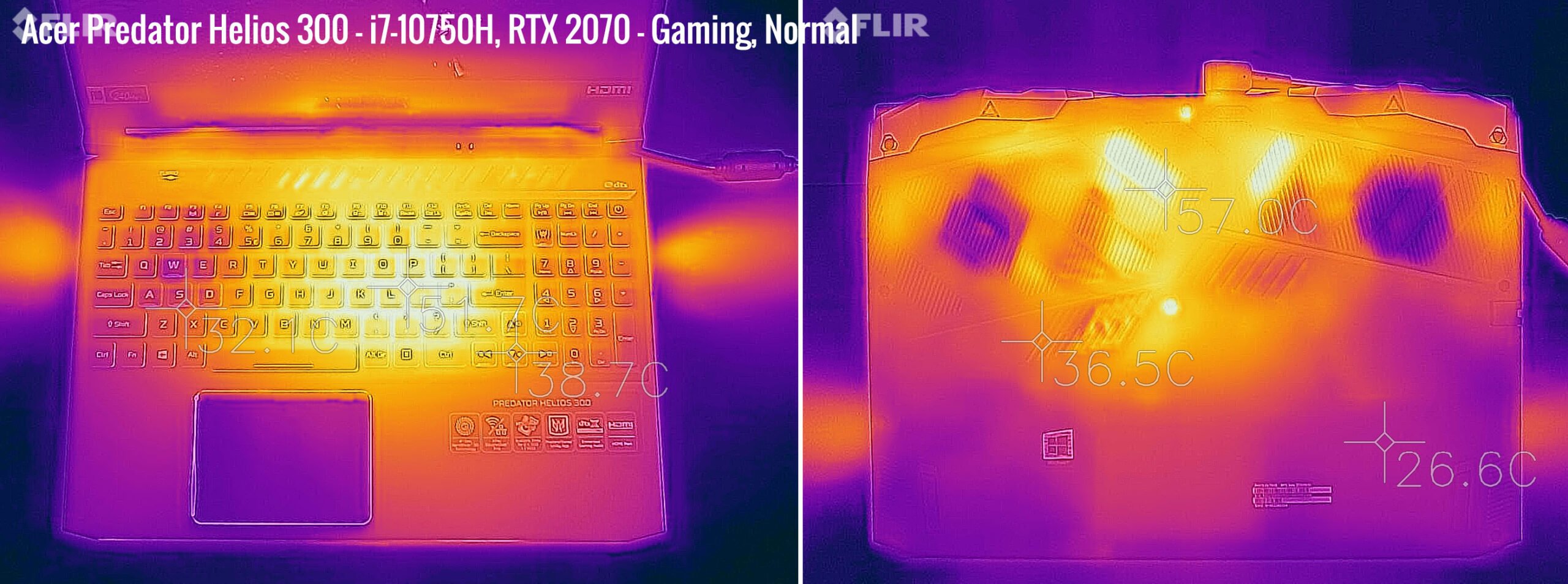
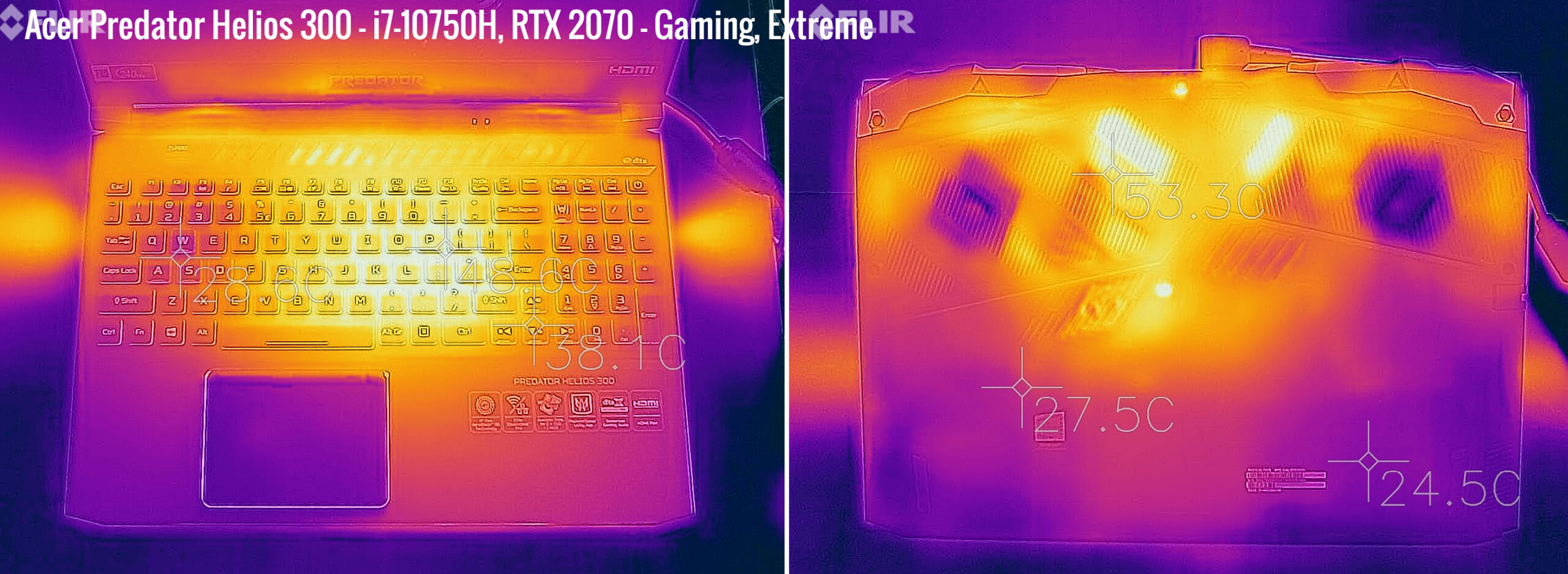
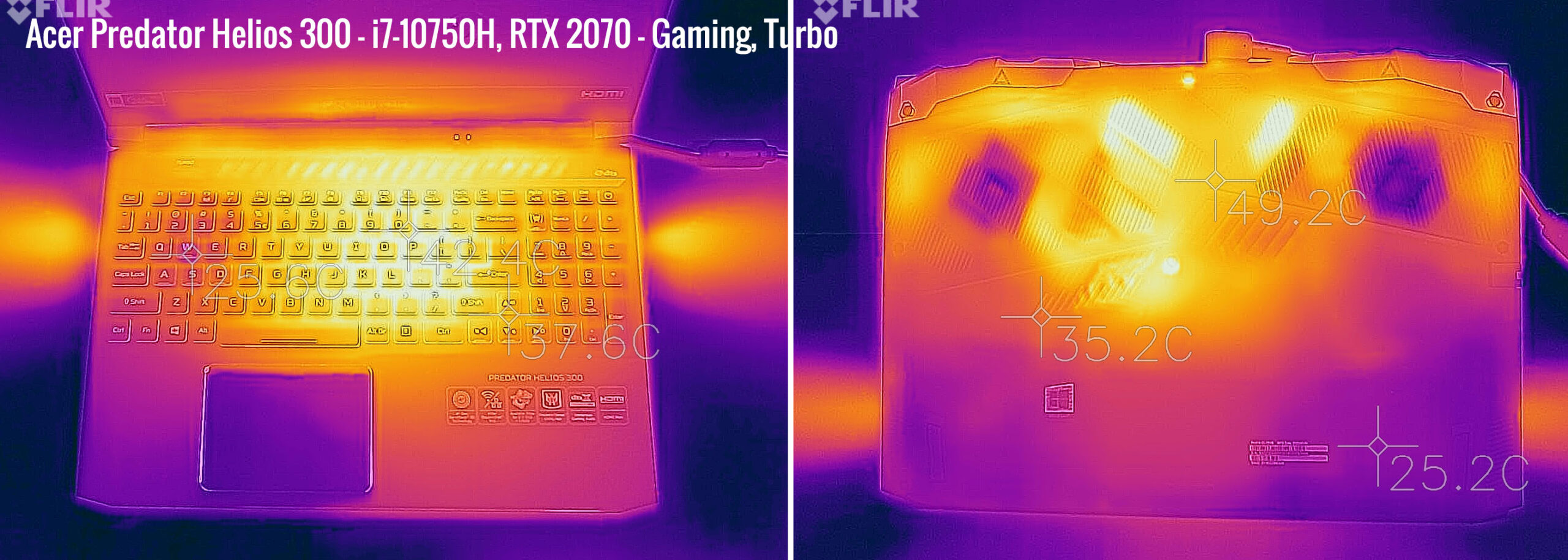
*Daily Use – streaming Netflix in EDGE for 30 minutes, Normal Profile, fans at 32-35 dB
*Gaming – Normal – playing Far Cry 5 for 30 minutes, Normal Profile, fans at 41-42 dB
*Gaming – Extreme– playing Far Cry 5 for 30 minutes, Extreme Profile, fans at 49-50 dB
*Gaming – Turbo– playing Far Cry 5 for 30 minutes, Turbo Profile, fans at 52-53 dB
For connectivity, there’s Gigabit Lan and Wireless 6 + Bluetooth through Realtek/Killer chips on this unit. We’ve mostly used the laptop on wireless, and it performed well in all our tests, both near the router and at 30+ feet away with obstacles in between.
The speakers are fire through cuts on the underbelly and don’t expect much from them. We measured volumes of around 73-75 dB at head-level, and experienced average to poor sound quality, with little at the lower end (on the Music profile in Nitro Sense). You’ll most likely want to hook up some headphones with this.
Finally, the camera is placed on top of the screen, flanked by microphones. It’s OK for occasional calls, but again, don’t expect much.
Battery life
There’s a 58Wh battery inside the Acer Predator Helios 300 series, which by this time is rather small for a notebook in its class.
Here’s what we got on our review unit, with the screen’s brightness set at around 120 nits (~60 brightness).
- 15 W (~3-4 h of use) – text editing in Google Drive, Power Saver Mode, screen at 60%, Wi-Fi ON;
- 11 W (~5-6 h of use) – 1080p fullscreen video on Youtube in Edge, Power Saver Mode, screen at 60%, Wi-Fi ON;
- 10.5 W (~5-6 h of use) – Netflix fullscreen in Edge, Power Saver Mode, screen at 60%, Wi-Fi ON;
- 22 W (~2-3 h of use) – browsing in Edge, Balance Mode, screen at 60%, Wi-Fi ON.
This top-tier Helios 300 configuration comes with a compact 230 W power-brick, and lower-tier configurations get a smaller and lighter 180W brick. The battery fills up in about 2 hours and there’s no support to USB-C charging.
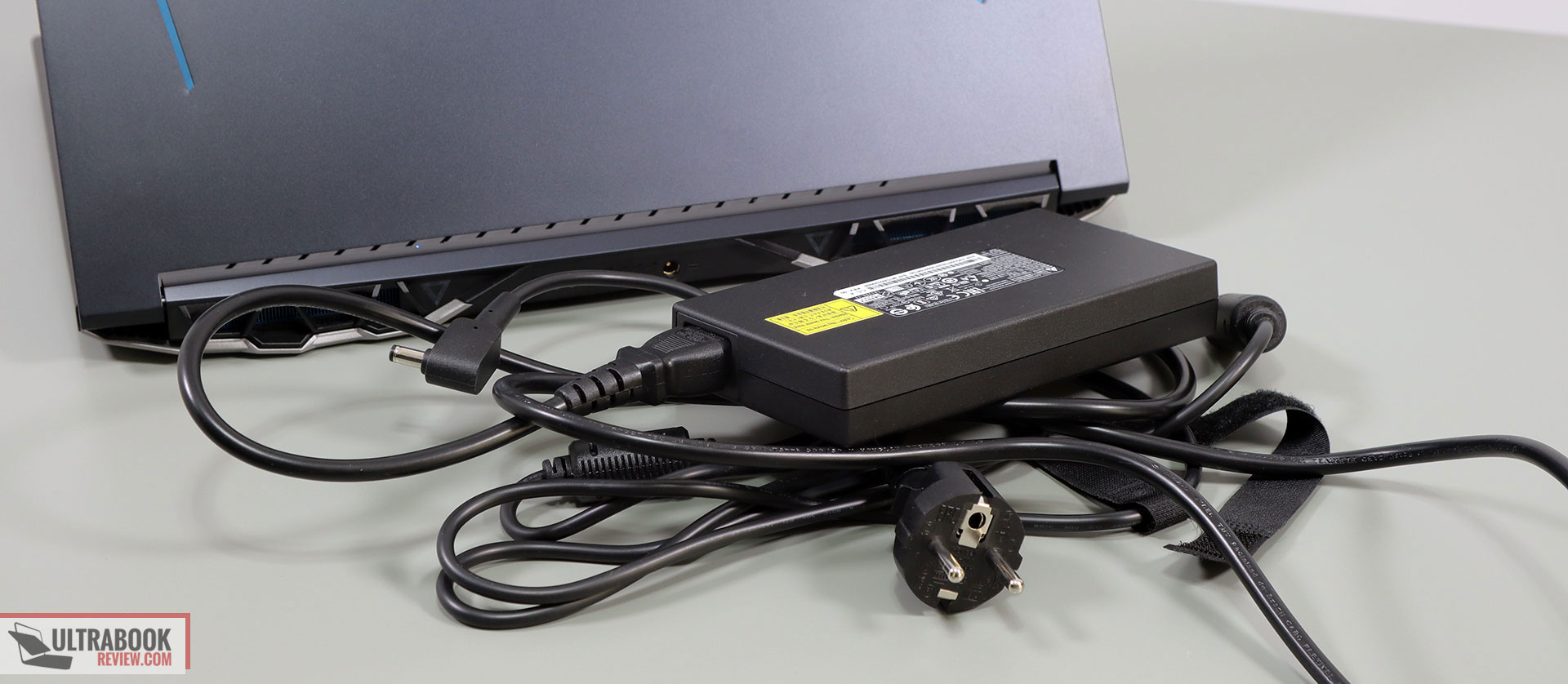
Price and availability
The 2020 Predator Helios 300 is already listed in stores in most regions as of late July 2020.
However, you’ll mostly find the mid-range GTX 1660Ti and RTX 2060 models with the 144 Hz, and hardly this RTX 2070 / 240 Hz version tested here. Nonetheless, those mid-tier models are the better value for your buck anyway.
The i7 + RTX 2060 configuration is listed for 1199 USD in the US and around 1400 EUR at the time of this review, making it one of the best-priced RTX 2060 notebooks on the market. Those are MSRP prices, not accounting for occasional discounts.
Follow this link for the latest updated prices and configurations available in your region.
Vs Competition
I’m going to cover this more in-depth in a separate article, but in a few words, there are two main types of performance/gaming notebooks you could consider as alternatives for this 2020 Acer Predator Helios 300.
On the Intel side, which is what I’d stick with if I’d be primarily looking for a gaming notebook, most of the similar tier options with similar specs are more expensive than this Helios 300, such as the ROG Strix G15 G512 or the MSI GP65 Leopard, with the closest matches being the Lenovo Legion 5i and the HP Omen 15t in some markets.
On the AMD side, which you should consider if you’re primarily after a powerful work computer and gaming comes as a secondary, there are a handful of options with 1660Ti/2060 level graphics right now, such as the Asus TUF Gaming A15, Lenovo Legion 5, HP Omen 15 and the various Tongfang-based models sold under different brands in various regions, such as XMG Core 15 in Europe or the Eluktronics RP-15 in the US. There’s a bigger list of options in this separate article.
None of these laptops is necessarily better than the Helios 300, but based on the available configurations and pricing in your regions, some of them might be the smarter buys for you. Just make sure to look into detailed reviews before buying, we’ve reviewed most of these laptops here on the site.
Final thoughts
While only a marginal upgrade of the popular 2019 model, the updated 2020 Acer Predator Helios 300 remains one the of best-value mid-range performance/gaming notebooks of this generation.
The solid build quality, gaming performance, and thermals remain some of its top-selling points, corroborated with the aggressive pricing that few other products match on the competitive markets in North America and Europe.
At the same time, though, some things have changed throughout this last year. For once, some of the competing designs offer larger batteries, improved inputs and better speakers now, but even so, the Helios remains competitive among its Intel-based piers.
Unfortunately, though, there’s no AMD variant, and that might steer some of you away. AMD’s Ryzen 4000 is more powerful, more efficient, and more affordable than the Intel platform, thus what I’d recommend in a competent work/school laptop, especially now that uncompromised designs are available. Intel configurations only keep a slight advantage in gaming performance, and the whole experience is enhanced by the properly cooled hardware implementation and the quiet fans on the balanced Normal profile, so gaming is where this Helios 300 remains a nearly unbeatable option, when you factor everything in. And what we recommend it for.
That pretty much wraps up our review of the 2020 Acer Predator Helios 300 PH315-53, but I’d like to hear what you think about it, so get in touch in the comments section down below.
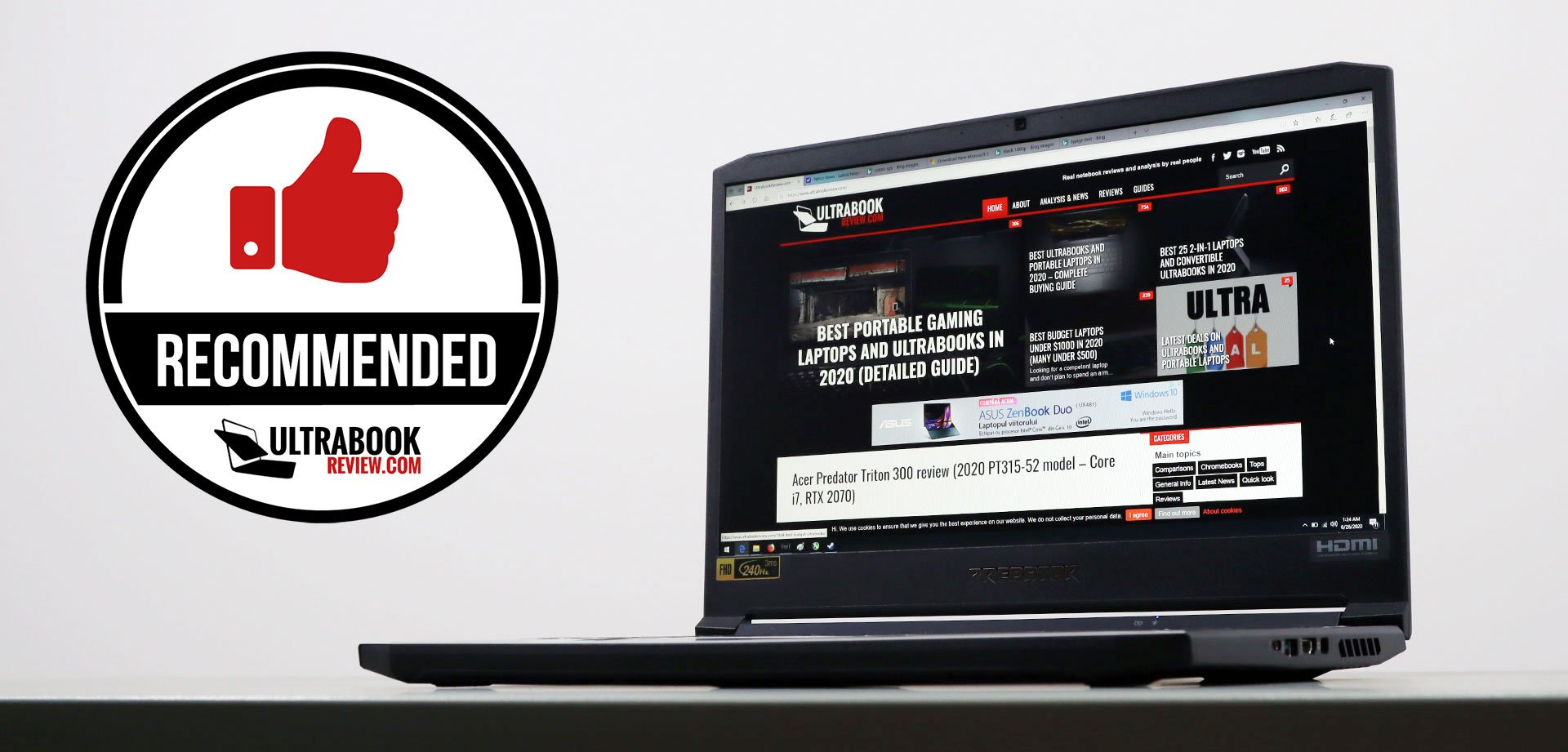
The post 2020 Acer Predator Helios 300 review (PH315-53 – Core i7, RTX graphics) appeared first on UltrabookReview.com


